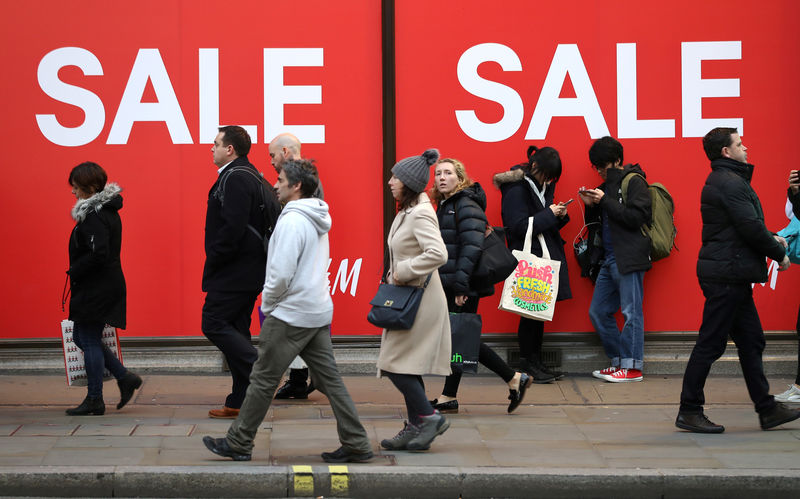 © Reuters. FILE PHOTO: Shoppers enjoy last-minute Christmas shopping in the week before Christmas on Oxford Street in London
© Reuters. FILE PHOTO: Shoppers enjoy last-minute Christmas shopping in the week before Christmas on Oxford Street in LondonBy Andy Bruce and Kate Holton
LONDON (Reuters) – British inflation unexpectedly held steady last month, denting market confidence about a Bank of England interest rate hike next month and sending sterling to a 10-month low against the dollar.
The pound tumbled towards $1.30 and 10-year British government bond yields () fell to their lowest since the end of May following the data, which also showed weakening in an underlying measure of inflation.
Despite motor fuel prices rising to their highest since 2014, annual consumer price inflation held in June at 2.4 percent, the Office for National Statistics (ONS) said.
Economists polled by Reuters had on average expected to see the first increase this year, to 2.6 percent.
Britain’s economy appears to be picking up after a slow first three months of the year, when unusually heavy snow hurt demand.
While the central bank worries that growth is close to the modest pace at which it will start to push up inflation, Wednesday’s data brought little sign of this.
Core inflation, which strips out energy, food, alcohol and tobacco prices, fell to 1.9 percent from 2.1 percent in May — below all forecasts and the weakest reading since March 2017.
“The large downside surprise adds more uncertainty around what had until now appeared a near-certain August rate hike,” JPMorgan (NYSE:) economist Allan Monks said.
Comments from BoE officials over the next week could be a “game changer”, Monks said, drawing parallels with May, when a spate of poor data thwarted a widely expected rate hike.
One measure of financial market pricing after Wednesday’s figures showed a roughly 70 percent chance of a move next month compared with nearly 80 percent before
PRESSURE IN THE PIPELINE?
On Tuesday data showed British workers’ wages rose at the slowest rate in six months during the three months to May despite a record number of people in jobs, challenging the BoE as it considers raising rates next month.
A Reuters poll of economists published on Tuesday showed 47 out of 75 thought the BoE would raise rates to a new post-financial crisis high of 0.75 percent in August. The remainder thought it would stay on hold. [BOE/INT]
Some economists said the weakness in June’s inflation data was driven by volatile components such as clothing, computer games and air fares which could soon rebound.
The ONS reported the biggest month-on-month drop in clothing prices for any June since 2012 as shops slashed prices for the summer sales.
Wednesday’s data suggested rising pressure in the pipeline for consumer prices, however.
Manufacturers increased the prices they charged by 3.1 percent in June compared with 3.0 percent in May. While a slightly weaker increase than expected, it marked the strongest rise this year.
The cost of raw materials – many of them imported – was 10.2 percent higher than in June 2017, the strongest rise in a year.
“The continued pick-up in producer prices suggests that inflation may rise a little in the short term as the recent oil price increases pass through supply chains,” said Suren Thiru, head of economics at the British Chambers of Commerce.
But any period of rising price growth was likely to be temporary, he added.
Source: Investing.com




























